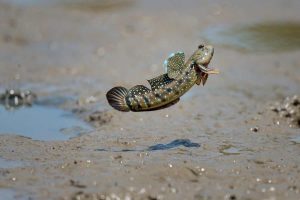
Once a day, Divya Ramesh and her colleagues drop fish food into the aquariums in their lab, feeding a menagerie of three unusual species: the ropefish, bichir, and mudskipper. All are amphibious fish whose specially adapted ways of breathing allow them to survive on land, from a few hours up to days.
“We study amphibious fishes because they’re so capable of moving across the water-land interface,” says Ramesh, a PhD student in mechanical engineering in Chen Li’s lab. Each species does it differently. The ropefish slithers like a snake, while the bichir assists its slither with its fins, akin to a human army-crawling. The mudskipper propels itself using its pelvic fins like a person using crutches — the only animal known to move like this.
Recently, Ramesh has studied how the animals move on mud of varying wetness. As the mud gets wetter, the mudskipper slows down. But the ropefish and bichir move just as fast. On drier mud, the ropefish and bichir lift their bodies to reduce drag.
But fish aren’t always cooperative. “The animals get tired and don’t want to move,” says Ramesh. To conduct their research more consistently, collaborator Gargi Sadalgekar, also a grad student in mechanical engineering at Hopkins, created a robot that could move like all three species. The team’s goal is to eventually develop robots that can navigate water, land, and the muddy in-between. Such robots could monitor soil properties near rivers or deliver first aid to people injured or stuck in these environments, says Ramesh.
The work has also shaped how Ramesh sees the world. “If I see any animals when I go outside, I start analyzing their movement,” she says, even that of her own dog. “He doesn’t run like other dogs,” she says — his gait includes an unusual gallop. “Why?”